History
In 1750 Charles VII of Naples, advised by minister Bernardo Tanucci, selected this place, originally the site of a royal hunting lodge for the Acquaviva family (now restored, and known as Palazzo del Belvedere), for an unusual social and technological experiment, a different model of production based on technical innovation and alert to the needs of workers. In its early days, San Leucio resort was a place for pleasure and a royal hunting preserve, built on the ruins of Saint Leucio church, where an aqueduct carried water to the waterfalls of the Royal Palace of Caserta, designed by Luigi Vanvitelli. The son of Charles, Ferdinand I, had a hunting lodge built for himself on this site. He was a very skillful hunter who disliked the pleasures and luxury of court life. It was here that Charles and the young King Ferdinand built a silk factory. The complex was transformed into a silk production site and industrial buildings were added, which was quite unique in late 18th-century Europe. Architect Francesco Collecini designed these industrial buildings, where noisy looms were installed next to royal apartments and a sitting room became a chapel for the workers.
A new village was built for workers' residences, and a large community of silk weavers grew into this industrial town, which in 1789 was deemed the "Real Colonia dei Setaioli" (the Silk Weavers Royal Colony). The king had planned to expand it into a true new city, called Ferdinandopoli, but the project was halted by the French invasion in 1799.
In San Leucio the most advanced technologies known in Europe at the time were used throughout the process to obtain the finished products. The members of the colony had a privileged status with a modern social security system. The French invasion stopped the complete realization of Ferdinandopoli, but San Leucio resort had further growth during French rule from 1806 to 1815.
Today
The heritage of King Ferdinand still survives today in the local silk and textile firms, which works on an international scale to elite foreign clients as the Buckingham Palace, the White House, the Quirinal Palace and the Chigi Palace.
San Leucio resort is home to a Living Silk Museum with some original old looms and machinery restored and displayed inside the Belvedere courtyard, showing all the phases of silk productions, from the old looms and machinery to finished products. From 1997 San Leucio resort is included in the UNESCO World Heritage List in Europe as part of the site 18th Century Royal Palace at Caserta with the Park, the Aqueduct of Vanvitelli and the San Leucio Complex. From 1999 in summer months at San Leucio the Leuciana Festival is held, to promote the Belvedere of San Leucio and its park.

The Royal Palace of Caserta is a former royal residence in Caserta, Campania, 35km north of Naples in southern Italy, constructed by the House of Bourbon-Two Sicilies as their main residence as kings of Naples. Located 35 km north of the historic center of Naples, Italy, the complex is the largest palace erected in Europe during the 18th century. In 1997, the palace was designated a UNESCO World Heritage Site; its nomination described it as "the swan song of the spectacular art of the Baroque, from which it adopted all the features needed to create the illusions of multidirectional space". The Royal Palace of Caserta is the largest former royal residence in the world, over 2 million m3 in volume and covering an area of 47,000 m2 and a floorspace of 138,000 square meters is distributed in the five stories of the building.
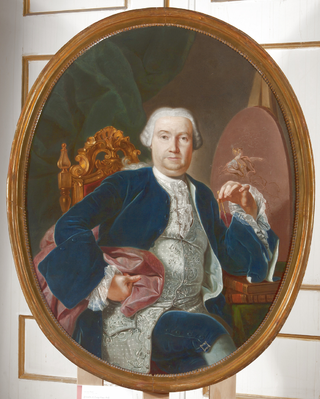
Luigi Vanvitelli, known in Dutch as Lodewijk van Wittel, was an Italian architect and painter. The most prominent 18th-century architect of Italy, he practised a sober classicising academic Late Baroque style that made an easy transition to Neoclassicism.

Caserta is the capital of the province of Caserta in the Campania region of Italy. An important agricultural, commercial, and industrial comune and city, Caserta is located 36 kilometers north of Naples on the edge of the Campanian plain at the foot of the Campanian Subapennine mountain range. The city is best known for the 18th-century Bourbon Royal Palace of Caserta.
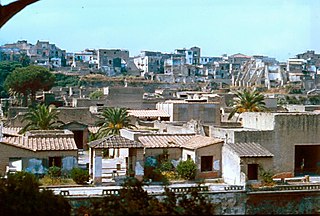
Ercolano is a town and comune in the Metropolitan City of Naples, Campania of Southern Italy. It lies at the western foot of Mount Vesuvius, on the Bay of Naples, just southeast of the city of Naples. The medieval town of Resina was built on the volcanic material left by the eruption of Vesuvius that destroyed the ancient city of Herculaneum, from which the present name is derived. Ercolano is a resort and the starting point for excursions to the excavations of Herculaneum and for the ascent of Vesuvius by bus. The town also manufactures leather goods, buttons, glass, and Lacryma Christi wine.

As one moves away from Naples in almost any direction, there is prominent musical activity to be found. These include, for example, the restoration and use of a number of the so-called "Vesuvian villas" in and near Ercolano, a string of once luxurious villas built in the 18th century and severely damaged by aerial bombardment in World War II. The most prominent of these is the Villa Campolieto, already restored, open and the site of chamber concerts by the Alessandro Scarlatti association.
Valle di Maddaloni is a comune (municipality) of 2 661 inhabitants in the Province of Caserta in the Italian region Campania, located about 30 kilometres (19 mi) northeast of Naples and about 7 kilometres (4 mi) east of Caserta.
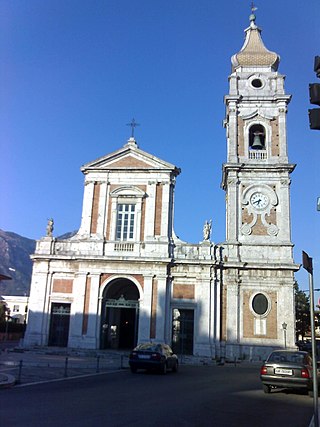
Airola is a comune (municipality) in the Province of Benevento in the Italian region Campania, located about 35 km northeast of Naples and about 20 km southwest of Benevento in the Valle Caudina, facing the Monte Taburno. Nearby is the confluence of the Tesa and Faenza streams into the Isclero River. Airola's territory is also crossed by the Acquedotto Carolino, carrying waters to the Caserta Palace.

Bucciano is a comune (municipality) in the Province of Benevento in the Italian region of Campania, located about 40 km northeast of Naples and about 20 km southwest of Benevento on the southern slopes of the Monte Taburno.
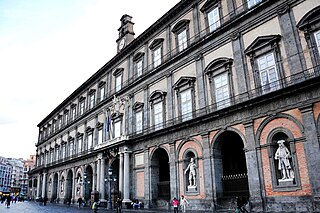
The Royal Palace of Naples is a palace, museum, and historical tourist destination located in central Naples, southern Italy.

San Domenico Maggiore is a Gothic, Roman Catholic church and monastery, founded by the friars of the Dominican Order, and located in the square of the same name in the historic center of Naples.
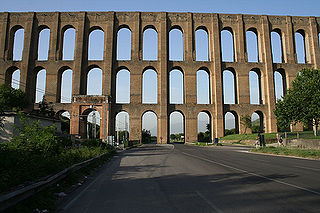
The Aqueduct of Vanvitelli or Caroline Aqueduct is a 38 km aqueduct that supplied water to the Reggia di Caserta and the San Leucio complex from the foot of the Taburno massif and springs of the Fizzo Contrada, in the territory of Bucciano.

Carlo Vanvitelli (1739–1821) was an Italian architect and engineer, who worked mainly in Naples and its surrounding area.
The Villa Giulia is a villa in Naples. It is located in the Barra district and is part of the Vesuvian villas of the Golden Mile.
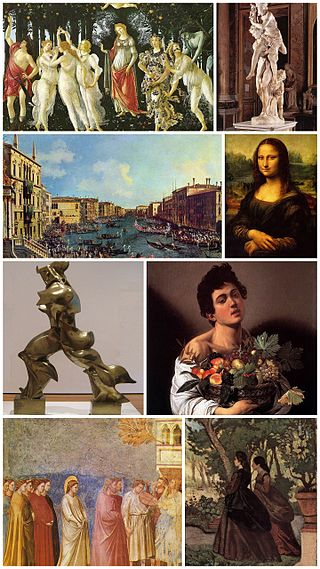
The 1700s refers to a period in Italian history and culture which occurred during the 18th century (1700–1799): the Settecento. The Settecento saw the transition from Late Baroque to Neoclassicism: great artists of this period include Vanvitelli, Canaletto and Canova, as well as the composer Vivaldi and the writer Goldoni.
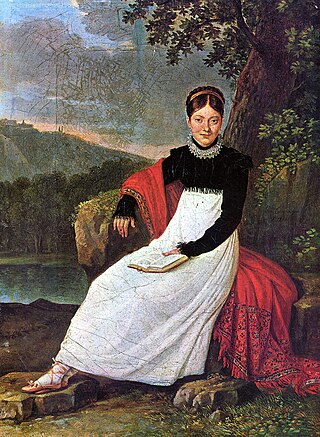
Giuseppe Cammarano was an Italian painter of frescoes and portraits.

The Royal Estate of Carditello includes a small 18th-century palace once belonging to the Neapolitan Bourbon Monarchy and its surrounding grounds in San Tammaro, a small village in the province of Caserta in the region of Campania.

Fedele Gioffredo Fischetti was an Italian painter of the Neoclassical period. Most of his works are frescoes of an allegorical or mythological nature.
Pallagrello bianco is a white Italian wine grape variety that is grown in Campania. The grape has a long history in the region and was one of the varieties planted in 1775 by architect and engineer Luigi Vanvitelli in the fan-shaped Vigna del Ventaglio vineyard created for the royal palace of King Ferdinand I of the Two Sicilies in Caserta. Following the phylloxera epidemic of the mid-19th century and the economic devastation of the World Wars of the early 20th century, plantings of Pallagrello bianco declined greatly and the variety was thought to be extinct until it was rediscovered growing in an abandoned Campanian vineyard in the 1990s.
Pallagrello nero is a red Italian wine grape variety that is grown in Campania. The grape has a long history in the region and, like the similarly named Pallagrello bianco, was one of the varieties planted in 1775 by architect and engineer Luigi Vanvitelli in the fan-shaped Vigna del Ventaglio vineyard created for the royal palace of King Ferdinand I of the Two Sicilies in Caserta. Following the phylloxera epidemic of the mid-19th century and the economic devastation of the World Wars of the early 20th century, plantings of Pallagrello nero declined greatly and the variety was thought to be extinct until it was rediscovered growing in an abandoned Campanian vineyard in the 1990s.
Pietro Saja was an Italian painter, active in Naples and Caserta in a Neoclassical style.
















